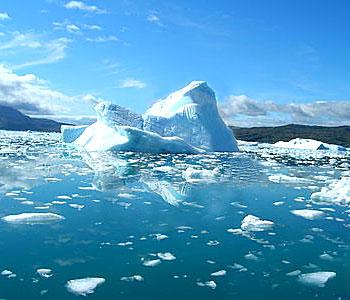Solids
States of Matter > Introduction
 Melting of ice
Ice in water bodies takes up the heat from surroundings
and supplies the heat to ice molecules to convert into water by increasing
the energy of the closely bound molecules. The energy supplied results in the
breaking of bonds and converting the ice into liquid. Melting of ice caps with
rise in global temperature is a major issue of concern for low lying cities like
Shanghai, Maldives etc.,
Melting of ice
Ice in water bodies takes up the heat from surroundings
and supplies the heat to ice molecules to convert into water by increasing
the energy of the closely bound molecules. The energy supplied results in the
breaking of bonds and converting the ice into liquid. Melting of ice caps with
rise in global temperature is a major issue of concern for low lying cities like
Shanghai, Maldives etc.,
The distance between neighboring atoms or molecules in a substance decides how tightly the binding is. In a solid, the atoms or molecules are very tightly bound. Matter in a solid state has a definite shape or form. It is generally defined in terms of the weight and density of the solid. Heat or temperature plays a very crucial role in the type of binding that occurs between the atoms. Pressure can bring about a change of state, too.
Effect of temperature on changing state:
- Solid to liquid conversion (Melting): If we heat ice, it changes into water. In this case, solid ice changes into liquid water, so a change of state has taken place. The process, in which a solid substance changes into a liquid on heating, is called melting (or fusion). So, when ice changes into water on heating, it is called melting of ice (or fusion of ice). The temperature, at which a solid substance melts and changes into a liquid at atmospheric pressure, is called melting point. Higher the melting point of a solid substance, greater will be the forces of attraction between its particles. For example, the melting point of iron metal is very high (1535°C) which tells us that the forces of attraction between the particles of iron are very strong.
- Mystery in solid conversion to liquid: On heating a solid, the molecules in the solid absorb the heat energy and start vibrating more and more violently. On absorption of enough heat energy, the molecules overcome the attractive forces between them and move apart. Thus the solid melts.
 When temperature of the atmosphere decreases to less than O°C
water vapor present in atmosphere freezes to ice resulting the outer surfaces
covered with ice.
When temperature of the atmosphere decreases to less than O°C
water vapor present in atmosphere freezes to ice resulting the outer surfaces
covered with ice.
- Liquid to solid conversion (Freezing): Freezing is the reverse process of melting. When water is cooled (by lowering its temperature by keeping in the freezer compartment of a refrigerator), it changes into solid ‘ice’. The process of conversion of a liquid into a solid by cooling is called freezing.
- Latent heat of fusion (solid to liquid conversion):
The heat required to convert a solid into the liquid state is called
latent heat of fusion or latent heat of melting.
- The latent heat of fusion of a solid is the quantity of heat in joules required to convert 1 kilogram of the solid (at its melting point) to liquid, without any change in temperature. Experiments shown that 3.34 × 105 joules of heat has to be supplied to change 1 kilogram of ice (at its melting point, 0°C) to water at the same temperature of 0°C. So, the latent heat of fusion of ice is 3.34 × 105 joules per kilogram.
- When a solid (ice) melts on heating, its temperature remains the same. So where do this heat energy goes? This heat energy is used up in changing the state of the solid substance by overcoming the forces of attraction between its particles.
- When a piece of ice is held in our hand, it feels much cold because when we hold it in our hand, it starts melting slowly as this ice takes the latent heat (required for melting) from our hand. Our hand loses heat to ice and hence we feel it to be cold.